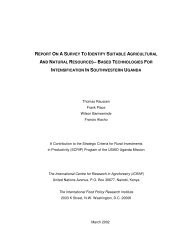Strategy for agricultural marketing and agro-processing ... - Foodnet
Strategy for agricultural marketing and agro-processing ... - Foodnet
Strategy for agricultural marketing and agro-processing ... - Foodnet
You also want an ePaper? Increase the reach of your titles
YUMPU automatically turns print PDFs into web optimized ePapers that Google loves.
3. AGRICULTURAL MARKETING IN UGANDA – RECENT EVOLUTION AND<br />
CURRENT CONSTRAINTS<br />
Over the past 20 years, the economy of Ug<strong>and</strong>a has undergone a rapid trans<strong>for</strong>mation - from a<br />
state of virtual collapse in the early 1980’s to a relatively strong rate of annual growth today.<br />
Much of the recovery has been achieved through sound Government policies linked to<br />
investments <strong>and</strong> structural adjustment programmes supported by the country’s development<br />
partners. Major components in the re<strong>for</strong>m process have been the adherence to market<br />
liberalisation <strong>and</strong> good governance.<br />
Whilst, <strong>for</strong> many countries, it has been proven that increased economic liberalisation <strong>and</strong><br />
openness lead to growth, it has also been recognised that in some cases <strong>and</strong> <strong>for</strong> some<br />
communities the transition from a protected, centrally-controlled economy may bring with it<br />
serious negative, short- <strong>and</strong> medium-term consequences. Ug<strong>and</strong>a has embraced these re<strong>for</strong>ms by<br />
removing the state’s role in market intervention, implementing a programme of rapid<br />
privatisation of national assets <strong>and</strong> adopting a highly-liberalised economic policy aimed at<br />
stimulating the private sector. This <strong>for</strong>mula has proved to be successful <strong>and</strong>, in recent years, the<br />
country has enjoyed GDP growth rates that have consistently been above 7 per cent.<br />
During this same period, many other developing countries have been implementing similar<br />
sector re<strong>for</strong>ms that included: (i) reduced state <strong>marketing</strong>, (ii) commodity diversification, (iii)<br />
increased production, (iv) privatisation, (v) implementing trade agreements through the WTO.<br />
The widespread adoption of market liberalisation tied to a strong emphasis on export promotion,<br />
has led to a period of relatively-rapid growth in these economies. However, it has also resulted<br />
in a situation in which domestic markets are exposed to the highly-competitive global<br />
<strong>agricultural</strong> market.<br />
In the past three years, this exposure has presented countries such as Ug<strong>and</strong>a with some serious<br />
difficulties. The combination of structural adjustment programmes <strong>and</strong> partial re<strong>for</strong>m of the<br />
rules governing international trade, has reduced the prices of the principal primary commodities<br />
exported by Ug<strong>and</strong>a at the same time as stimulating an increase in exports of <strong>agricultural</strong><br />
products by more-competitive producers, some of whom continue to provide a high level of<br />
subsidies to their farmers.<br />
The result of oversupply <strong>and</strong> weakening dem<strong>and</strong> due to the current recession, has led to many<br />
commodity prices falling to a 40-year low. Analysts suggest that commodity prices are likely to<br />
remain at these levels <strong>for</strong> the <strong>for</strong>eseeable future. This bleak outlook is reflected in the dramatic<br />
reduction in the terms of trade <strong>for</strong> countries such as Ug<strong>and</strong>a, <strong>and</strong> suggests a profound downturn<br />
in their economic outlook <strong>and</strong> per<strong>for</strong>mance.<br />
Ug<strong>and</strong>a’s development partners have recognised some of these difficulties <strong>and</strong> are making<br />
serious ef<strong>for</strong>ts to assist Ug<strong>and</strong>a in overcoming them. Programmes such as the EU-supported<br />
Ug<strong>and</strong>a Programme <strong>for</strong> Trade Opportunities <strong>and</strong> Policy (UPTOP) <strong>and</strong> the USAID-funded<br />
Ug<strong>and</strong>a Trade Revitalisation <strong>and</strong> Diversification of Exports (U-TRADE) <strong>and</strong> Agricultural<br />
Productivity Enhancement Programme (APEP) projects, as well as the government’s own<br />
Strategic Exports Interventions’ initiative, are all examples of attempts to diversify export<br />
products, add value to commodities <strong>and</strong> initiate new <strong>for</strong>ms of industrial growth. At the same<br />
time, budget support to Ug<strong>and</strong>a has increased considerably while HIPC debt relief programmes<br />
are enabling the government to broaden the support it provides to the social sectors.<br />
4
















